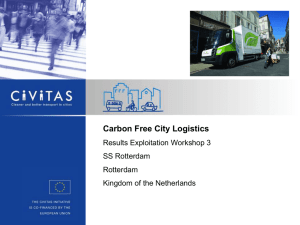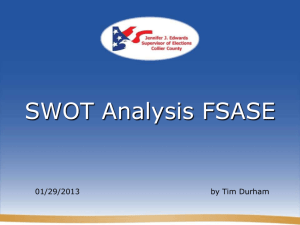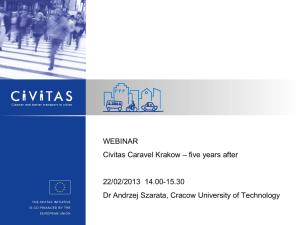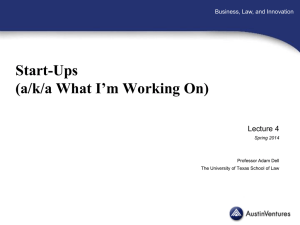Civitas Michael Clarkson Stephen Chong Andrew Myers
advertisement
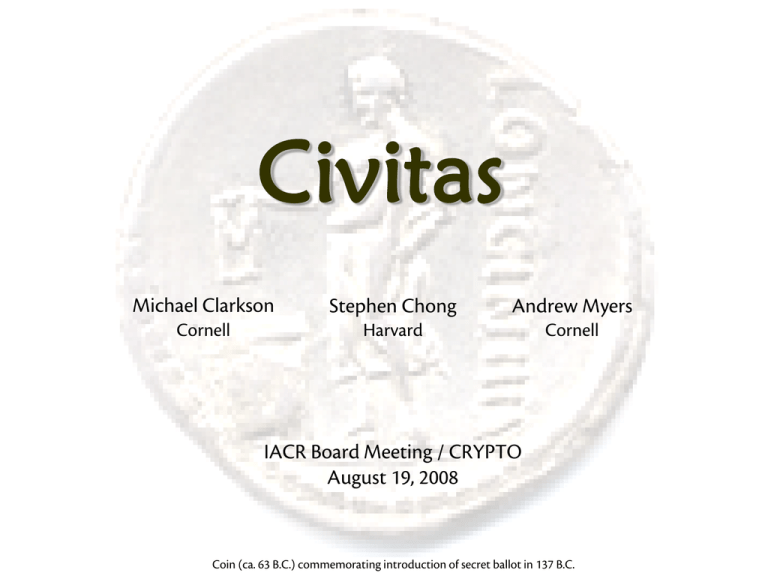
Civitas Michael Clarkson Stephen Chong Andrew Myers Cornell Harvard Cornell IACR Board Meeting / CRYPTO August 19, 2008 Coin (ca. 63 B.C.) commemorating introduction of secret ballot in 137 B.C. Civitas Features: – Designed for remote voting, coercion resistance, verifiability – Supports plurality, approval, Condorcet methods Status: – Paper in Oakland 2008 – Publicly available: 21,000 LOC (Jif, Java, and C) – Prototype …Suitable for IACR? Clarkson: Civitas 2 Civitas Security Requirements Security Model No trusted supervision of polling places – Including voters, procedures, hardware, software – Voting could take place anywhere Remote voting Generalization of “Internet voting” and “postal voting” Interesting problem to solve! IACR Clarkson: Civitas 4 Adversary Always: – May perform any polynomial time computation – May corrupt all but one of each type of election authority Distributed trust Almost always: – May control network – May coerce voters, demanding secrets or behavior, remotely or physically Security properties: Confidentiality, integrity, availability Clarkson: Civitas 5 Integrity Verifiability: The final tally is correct and verifiable. Including: – Voter verifiability: Voters can check that their own vote is included – Universal verifiability: Anyone can check that only authorized votes are counted, no votes are changed during tallying [Sako and Killian 1995] IACR Clarkson: Civitas 6 Confidentiality Voter coercion: – Employer, spouse, etc. – Coercer can demand any behavior (vote buying) – Coercer can observe and interact with voter during remote voting Must prevent coercers from trusting their own observations Clarkson: Civitas 7 Confidentiality Coercion resistance: The adversary cannot learn how voters vote, even if voters collude and interact with the adversary. > receipt-freeness > anonymity too weak for remote voting Hierarchy: [Delaune, Kremer, and Ryan, CSFW 2006] IACR ? Clarkson: Civitas 8 Availability Tally availability: The final tally of the election is produced. • We assume that this holds • To guarantee, would need to make system components highly available IACR ? Clarkson: Civitas 9 Civitas Design and Implementation JCJ Scheme [Juels, Catalano, and Jakobsson, WPES 2005] – Formally defined coercion resistance and verifiability – Constructed voting scheme – Proved scheme satisfies coercion resistance and verifiability [Backes, Hritcu, and Maffei, CSF 2008] – Verified simplification in ProVerif Clarkson: Civitas 11 Civitas Architecture registration registration teller registration teller teller tabulation teller ballot box ballot box ballot box voter client Clarkson: Civitas tabulation teller bulletin board tabulation teller 12 Registration registration registration teller registration teller teller tabulation teller ballot box ballot box ballot box voter client tabulation teller bulletin board tabulation teller Voter retrieves credential share from each registration teller; combines to form credential Clarkson: Civitas 13 Voting registration registration teller registration teller teller tabulation teller ballot box ballot box ballot box voter client tabulation teller bulletin board tabulation teller Voter submits copy of encrypted choice and credential (+ ZK proofs) to each ballot box Clarkson: Civitas 14 Resisting Coercion Voters invent fake credentials – To adversary, fake real – Votes with fake credentials removed during tabulation Clarkson: Civitas 15 Resisting Coercion If the adversary demands that the voter… Then the voter… Submits a particular vote Does so with a fake credential. Sells or surrenders a credential Supplies a fake credential. Abstains Supplies a fake credential to the adversary and votes with a real one. Clarkson: Civitas 16 Tabulation registration registration teller registration teller teller tabulation teller ballot box ballot box ballot box voter client tabulation teller bulletin board tabulation teller Tellers retrieve votes from ballot boxes Clarkson: Civitas 17 Tabulation registration registration teller registration teller teller tabulation teller ballot box ballot box ballot box voter client tabulation teller bulletin board tabulation teller Tabulation tellers anonymize votes with mix network; eliminate unauthorized credentials; decrypt remaining choices; post ZK proofs Clarkson: Civitas 18 Civitas Architecture registration registration teller registration teller teller tabulation teller ballot box ballot box ballot box voter client Verifiability: Tellers post zero-knowledge proofs during tabulation Clarkson: Civitas tabulation teller bulletin board tabulation teller Coercion resistance: Voters can undetectably fake credentials 19 Protocols Leverage the literature: – – – – – – – – El Gamal; distributed [Brandt]; non-malleable [Schnorr and Jakobsson] Proof of knowledge of discrete log [Schnorr] Proof of equality of discrete logarithms [Chaum & Pederson] Authentication and key establishment [Needham-Schroeder-Lowe] Designated-verifier reencryption proof [Hirt & Sako] 1-out-of-L reencryption proof [Hirt & Sako] Signature of knowledge of discrete logarithms [Camenisch & Stadler] Reencryption mix network with randomized partial checking [Jakobsson, Juels & Rivest] – Plaintext equivalence test [Jakobsson & Juels] Clarkson: Civitas 20 Secure Implementation In Jif [Myers 1999, Chong and Myers 2005, 2008] – Security-typed language – Types contain information-flow policies • Confidentiality, integrity, declassification, erasure If policies in code express correct requirements… – (And Jif compiler is correct…) – Then code is secure w.r.t. requirements Clarkson: Civitas 21 Civitas Security Evaluation Civitas Trust Assumptions 1. DDH, RSA, random oracle model. 2. The adversary cannot masquerade as a voter during registration. 3. Voters trust their voting client. 4. At least one of each type of authority is honest. 5. The channels from the voter to the ballot boxes are anonymous. 6. Each voter has an untappable channel to a trusted registration teller. Clarkson: Civitas 23 Civitas Trust Assumptions 1. DDH, RSA, random oracle model. 2. The adversary cannot masquerade as a voter during registration. Verifiability and Coercion resistance Voters trust their voting client. 3. 4. At least one of each type of authority is honest. Coercion resistance 5. The channels from the voter to the ballot boxes are anonymous. 6. Each voter has an untappable channel to a trusted registration teller. Clarkson: Civitas 24 Civitas Trust Assumptions 1. DDH, RSA, random oracle model. 2. The adversary cannot masquerade as a voter during registration. 3. Voters trust their voting client. 4. At least one of each type of authority is honest. 5. VER + CR CR The channels from the voter to the ballot boxes are anonymous. 6. Each voter has an untappable channel to a trusted registration teller. Clarkson: Civitas 25 Civitas Trust Assumptions 1. DDH, RSA, random oracle model. 2. The adversary cannot masquerade as a voter during registration. 3. Voters trust their voting client. 4. At least one of each type of authority is honest. 5. VER + CR CR The channels from the voter to the ballot boxes are anonymous. 6. Each voter has an untappable channel to a trusted registration teller. Clarkson: Civitas 26 Civitas Trust Assumptions 1. DDH, RSA, random oracle model. 2. The adversary cannot masquerade as a voter during registration. 3. Voters trust their voting client. 4. At least one of each type of authority is honest. 5. VER + CR CR The channels from the voter to the ballot boxes are anonymous. 6. Each voter has an untappable channel to a trusted registration teller. Clarkson: Civitas 27 Civitas Trust Assumptions 1. DDH, RSA, random oracle model. 2. The adversary cannot masquerade as a voter during registration. 3. Voters trust their voting client. 4. At least one of each type of authority is honest. 5. VER + CR CR The channels from the voter to the ballot boxes are anonymous. 6. Each voter has an untappable channel to a trusted registration teller. Clarkson: Civitas 28 Civitas Trust Assumptions 1. DDH, RSA, random oracle model. 2. The adversary cannot masquerade as a voter during registration. 3. Voters trust their voting client. 4. At least one of each type of authority is honest. 5. VER + CR CR The channels from the voter to the ballot boxes are anonymous. 6. Each voter has an untappable channel to a trusted registration teller. Clarkson: Civitas 29 Civitas Trust Assumptions 1. DDH, RSA, random oracle model. 2. The adversary cannot masquerade as a voter during registration. 3. Voters trust their voting client. 4. At least one of each type of authority is honest. 5. VER + CR CR The channels from the voter to the ballot boxes are anonymous. 6. Each voter has an untappable channel to a trusted registration teller. Clarkson: Civitas 30 Civitas Trust Assumptions 1. DDH, RSA, random oracle model. 2. The adversary cannot masquerade as a voter during registration. 3. Voters trust their voting client. 4. At least one of each type of authority is honest. 5. VER + CR CR The channels from the voter to the ballot boxes are anonymous. 6. Each voter has an untappable channel to a trusted registration teller. Clarkson: Civitas 31 Civitas Cost Evaluation Real-World Cost Society makes a tradeoff on: – Cost of election, vs. – Security, usability, … Current total costs are $1-$3 / voter [International Foundation for Election Systems] We don’t know the total cost for Civitas. Cost of cryptography? Clarkson: Civitas 33 CPU Cost for Tabulation For reasonable security parameters, CPU time is 39 sec / voter / authority. If CPUs are bought, used (for 5 hours), then thrown away: $1500 / machine ) $12 / voter If CPUs are rented: $1 / CPU / hr ) 4¢ / voter Increased cost…Increased security IACR ? Clarkson: Civitas 34 Conclusion Summary Civitas provides security: – Remote voting – Verifiability – Coercion resistance (strongest?) Civitas provides assurance: – Security proofs – Explicit trust assumptions – Information-flow analysis of implementation (first?) IACR Clarkson: Civitas 36 Technical Issues • Web interfaces • Testing • BFT bulletin board • Threshold cryptography • Anonymous channel integration IACR Clarkson: Civitas 37 Research Issues • Distribute trust in voter client • Eliminate in-person registration • Credential management • Application-level DoS Clarkson: Civitas 38 Web Site http://www.cs.cornell.edu/projects/civitas • Technical report with concrete protocols • Source code of our prototype Clarkson: Civitas 39 http://www.cs.cornell.edu/projects/civitas Extra Slides Clarkson: Civitas 41 Paper • • What paper does: – Convince voter that his vote was captured correctly What paper does next: – Gets dropped in a ballot box – Immediately becomes insecure • • Chain-of-custody, stuffing, loss, recount attacks… • Hacking paper elections has a long and (in)glorious tradition [Steal this Vote, Andrew Gumbel, 2005] • 20% of paper trails are missing or illegible [Michael Shamos, 2008] What paper doesn’t: – Guarantee that a vote will be counted – Guarantee that a vote will be counted correctly Clarkson: Civitas 42 Cryptography “The public won’t trust cryptography.” – It already does… – Because experts already do “I don’t trust cryptography.” – You don’t trust the proofs, or – You reject the hardness assumptions Clarkson: Civitas 43 Selling Votes Requires selling credential… – Which requires: • Adversary tapped the untappable channel, or • Adversary authenticated in place of voter… – Which then requires: • Voter transferred ability to authenticate to adversary; something voter… – Has: too easy – Knows: need incentive not to transfer – Is: hardest to transfer Clarkson: Civitas 44 Civitas LOC Component Approx. LOC Tabulation teller 5,700 Registration teller 1,300 Bulletin board, ballot box 900 Voter client 800 Other (incl. common code) Total Jif LOC Low-level crypto and I/O (Java and C) Total LOC Clarkson: Civitas 4,700 Policy Distinct annotations Confidentiality 20 Integrity 26 13,400 8,000 21,400 45 Civitas Policy Examples • Confidentiality: – Information: Voter’s credential share – Policy: “RT permits only this voter to learn this information” – Jif syntax: RT Voter • Confidentiality: – Information: Teller’s private key – Policy: “TT permits no one else to learn this information” – Jif syntax: TT TT • Integrity: – Information: Random nonces used by tellers – Policy: “TT permits only itself to influence this information” – Jif syntax: TT TT Clarkson: Civitas 46 Civitas Policy Examples • Declassification: – Information: Bits that are committed to then revealed – Policy: “TT permits no one to read this information until all commitments become available, then TT declassifies it to allow everyone to read.” – Jif syntax: TT [TT commAvail ] • Erasure: – Information: Voter’s credential shares – Policy: “Voter requires, after all shares are received and full credential is constructed, that shares must be erased.” – Jif syntax: Voter [Voter credConst T ] Clarkson: Civitas 47 Registration Trust Assumptions One way to discharge is with in-person registration – Not an absolute requirement • Though for strong authentication, physical presence (“something you are”) is reasonable – Need not register in-person with all tellers Works like real-world voting today: – Registration teller trusted to correctly authenticate voter – Issue of credential must happen in trusted “registration booth” – But doesn’t need to happen on special day Con: Pro: System not fully remote Credential can be used remotely for many elections Reusing real-world mechanism, can bootstrap into a system offering stronger security Clarkson: Civitas 48 Voting Client Trust Assumption Civitas voting client is not a DRE: – Voters are not required to trust a single (closedsource) implementation – Civitas allows open-source (re)implementations of the client – Voters can obtain or travel to implementation provided by organization they trust Discharge? Distribute trust in client. [Benaloh, Chaum, Joaquim and Ribeiro, Kutyłowski et al., Zúquete et al., …] Clarkson: Civitas 49 Blocks Block is a “virtual precinct” – Each voter assigned to one block – Each block tallied independently of other blocks, even in parallel Tabulation time is: – Quadratic in block size – Linear in number of voters • If using one set of machines for many blocks – Or, constant in number of voters • If using one set of machines per block Clarkson: Civitas 50 Tabulation Time vs. Anonymity # voters = K, # tab. tellers = 4, security strength ≥ 112 bits [NIST 2011–2030] Clarkson: Civitas 51 Tabulation Time vs. # Voters sequential parallel K = 100 Clarkson: Civitas 52 Ranked Voting Methods Voters submit ranking of candidates – e.g., Condorcet, Borda, STV – Help avoid spoiler effects – Defend against strategic voting – “Italian attack” Civitas implements coercion-resistant Condorcet, approval and plurality voting methods – Could do any summable method Clarkson: Civitas 53
